They Knew it Would Burn, Reveals Grenfell Inquiry

By Frances Howe, LLB
Evidence provided to the Grenfell Inquiry in November revealed several construction material suppliers knew about the combustible nature of the cladding years before the fire would claim 72 lives.
‘Suppliers knew about the combustible nature of the cladding years before the fire would claim 72 lives.’
Fire safety tests performed on the cladding were over-engineered and ‘dishonest’ revealed ex-project manager, Jonathan Roper of Colotex. Colotex supplied the foam insulation panels for the Grenfell Tower block.
Roper gave evidence to the Inquiry that the panels had initially failed a fire safety test in 2014, performed three years before the Grenfell Tower fire on 14 June 2017. Despite this, the company marketed the cladding as fire safe after adding magnesium oxide before a second, and this time successful, test. On 19 November, former technical supervisor at Celotex, Jamie Hays, gave evidence that it was his idea to add the magnesium oxide in order for the insulation to pass the second test. However, he claimed to have no knowledge that the product would be marketed and sold without disclosing the use of the added material.
Roper told the inquiry that this marketing tactic was ‘intended to mislead’ and that he felt ‘incredibly uncomfortable with it.’
Evidence has been presented to the Inquiry in regards to three construction suppliers involved in providing the combustible cladding that set alight on the Grenfell Tower. The companies, Celotex, Arconic and Kingspan, have all denied wrongdoing.
During the inquiry, emails from Arconic, who supplied combustible aluminium composite material panels used in the cladding system, revealed senior executives had prior knowledge of the ‘VERY CONFIDENTIAL’ combustible nature of the product.
The Arconic panels were chosen by the Kengington and Chelsea Tenant Management Organisation (KCTMO) in an attempt to reduce the cost of construction on the refurbishment of the Grenfell Tower. Emails from a senior executive at Arconic, Claude Wehrle, shown to the Inquiry, revealed knowledge of other cases of high-rise buildings with similar cladding catching on fire. Wehrle’s emails dated as early as 2009, eight years before the Grenfell Tower fire.
These hearings are a part of the second phase of the Grenfell Tower Inquiry which began on 28 January 2020. The first phase investigated the events of the fire on 14 June 2017 whereas this second phase aims to investigate wider causes behind the event. The Inquiry was established under former Prime Minister, Theresa May. On 29 June 2017, May published a statement in which she affirmed that ‘no stone will be left unturned by this inquiry.’ The Inquiry will continue to hear evidence against the cladding suppliers.
Photo Caption: ‘Grenfell, forever in our hearts’ – Grenfell Tower in July of 2018 (Credit: Chiral Miller via Flickr).



